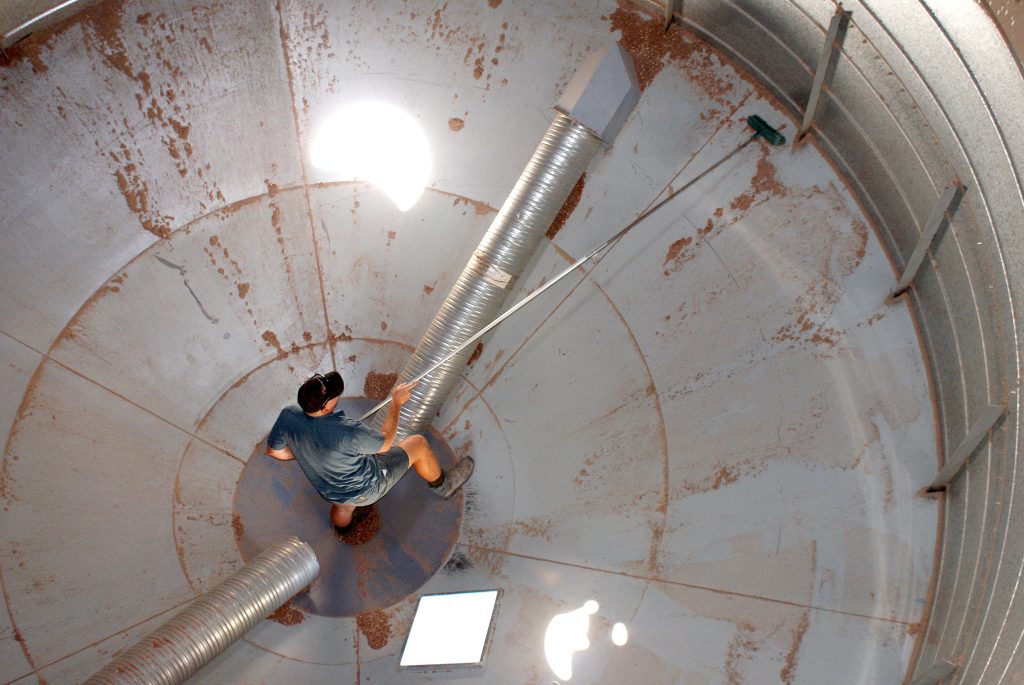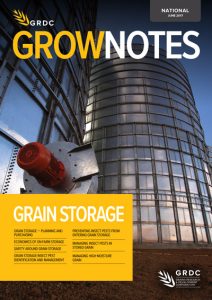The biggest challenge when storing grain is dealing with insects (such as weevils) and prevention is ALWAYS better than cure.
Controlling insects once they infest grain can only be done with fumigation or controlled atmosphere, both of which require gas-tight sealable storage. For storages that cannot be sealed, prevention is our only management option, short of transferring grain out via gas-tight silos to batch fumigate.
Hygiene
Hygiene is the first defence and extends beyond the storage and surrounds. Whole farm hygiene includes cleaning out any equipment that handles or holds grain, including stock feeding equipment. Dispose of waste grain by feeding out to stock, burying or spreading out thinly over the ground to rot. A pile or drum of waste grain is a perfect breeding ground for insects, negating all our hard work in cleaning up.

Clean Sweep. The first defence against grain storage insects is hygiene and it extends beyond the silos and surrounds to anything the handles or holds grain (photo by Chris Warrick).
Once clean, storages and equipment can be treated with diatomaceous earth (DE) to ensure there are no surviving insects left to reinfest newly harvested grain. Recent testing revealed that an 18 volt battery or petrol-powered leaf blower was the most effective way to distribute the DE throughout a cone or flat bottom silo from the bottom. A venturi gun on a standard air compressor can also be used, but was not as effective during the tests.
While preparing storages for harvest, check and maintain seals, conduct structural repairs and consider improvements to make them easier to clean. Storages (like any farm equipment) must be made safe to operate in and around, including a secure way to access the top for monitoring and maintenance.
Protectants
Protectants are an insect prevention tool for cereal grain. Because some markets (particularly international buyers) require pesticide residue-free grain (PRF), protectants are often suited to domestic feed cereals in unsealable storage, where fumigation is not an option.
Product choice in Western Australia is limited; in other states it can be simplified to two decisions.
A registered grain storage protectant with the active ingredient of spinosad and s-methoprene or deltamethrin and piperonyl butoxide should be rotated every year or two, but if the lesser grain borer has been identified on the property, then spinosad and s-methoprene has higher efficacy (which is why correct identification of the insects in your sampling is so important).
The second decision is to choose a mixing partner containing either fenitrothion or chlorpyrifos-methyl (if either one is not already included with the spinosad or deltamethrin product). The mixing partner provides protection against the rice weevil, however this choice needs to include consideration for the type of grain being stored, the withholding period and market acceptance. Fenitrothion is registered for more types of cereals but has a 90 day withholding period if applied at the nine month protection rate. Chlorpyrifos-methyl has no withholding period but is not registered for malt barley or rice and is accepted by fewer markets. Always check market acceptance and read and follow label directions.
Aeration
Aeration cooling is the other key component to insect prevention. By cooling grain down, insects are not as attracted and are less likely to infest. If cooled to 15 degrees Celsius, insects cannot breed in the grain. Additional benefits of aeration cooling include preventing mould, temporarily holding over moisture grain (until it can be dried, blended or fed to stock), and shortening the vent time to clear gas after fumigation.
Aeration cooling can be retrofitted relatively easily to cone bottom silos and is most efficiently operated by an automatic controller. Select aeration systems that can produce 2-3 litres of air per second per tonne of grain, and it’s worth specifying to aeration equipment suppliers what grains are being stored to ensure the fan can handle the backpressure induced by the grain type. Also check with suppliers if their quoted airflow rates are calculated or field tested, as the performance of an aeration system in working conditions can be significantly lower than the theoretical, calculated rates.
Monitoring grain temperature and checking for insects is an essential part of preventing issues in stored grain. Use simple probe traps and thermometers pushed into the top of the grain stack. Access ports can be fitted into the side of storages to attain readings throughout the stack, and remote monitoring equipment can also be installed to provide real time readings back to a dashboard or mobile device.
The content in this article was covered in more detail in a GRDC Online Update held on 23 October 2024. View the webinar recording at the GRDC website.

Article by Chris Warrick for the GRDC Grain Storage Extension Team.

